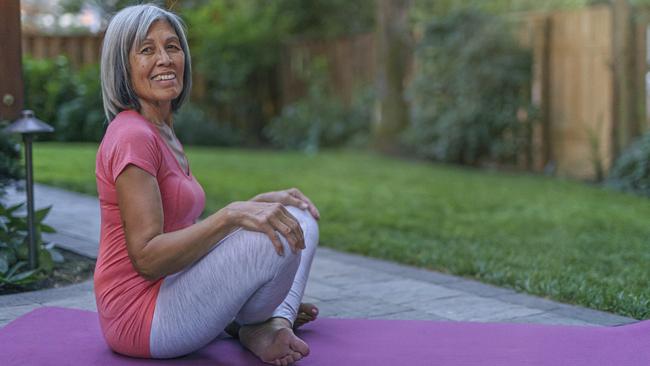Twelve mid-life habits that will have a lasting impact on your health
A study has found that just a monthly jog is enough to reduce the risk of dementia. It’s not the only easy lifestyle change with a big benefit.

Even small health habits will pay off if you stick to them throughout your adult life. In a study published last week, Dr Sarah-Naomi James of the MRC Unit for Lifelong Health & Ageing at University College London found that staying consistently fit and active, even if that means jogging, swimming or cycling once a month, brings far greater brain health benefits than taking up a hardcore weekly class only to quit after a few months.
It’s never too late to start an exercise habit – people who take up exercise in their sixties have better cognitive function than those who were never active, the research suggests – but consistency is key. “The effect is accumulative, so the longer an individual is active, the more likely they are to have higher later-life cognitive function,” James says.
More proof that habits can have a powerful effect on health came from researchers tracking 167,946 UK adults aged 60 or older that showed that a combination of seven healthy lifestyle habits is linked to a lower risk of dementia in people with type 2 diabetes. Over 12 years, participants who followed all seven healthy habits – no smoking, moderate alcohol consumption, at least two and a half hours of moderate exercise or 75 minutes of vigorous exercise per week, seven to nine hours of sleep, getting your five a day, watching television less than four hours a day, and socialising at least once a week – were found to be at a 54 per cent lower risk of dementia than those who followed two or fewer.
Jennifer Wild, a consultant clinical psychologist, associate professor at the University of Oxford and the author of Be Extraordinary (Robinson), says that starting small is key to forming good habits. “Give yourself permission to try something new for just three minutes a day or week and to make an average job of it rather than a perfect job,” Wild says. “The real challenge is to make something part of your routine and once it is a regular fixture you can increase the duration or frequency.”
Here are the healthiest habits to create:
1. Jog or swim once a month to slow brain ageing
In her UCL study, which involved 1417 adults, James found that working out, “even at light levels of activity, between once to four times a month … has a positive effect on cognition”.
2. Do 10 star jumps every day for stronger bones
Bone is a living tissue and exercise that includes an element of “gravitational impact” – movements that shift your body off the ground so you land with jolts – makes it grow stronger. A study from the School of Health and Sport Sciences at Chukyo University in Japan found that doing “ten repetitions per day can increase bone mass and strength” in the legs and spine. No additional bone benefits were accrued by doubling the number of jumps.
3. Step outside first thing to improve your sleep
Last year researchers at the University of Washington looked at why the sleep patterns of a group of people changed during winter months, resulting in them going to sleep later in the evening and waking up later each morning. Results suggested that with less daylight exposure on winter days the participants’ body clocks were thrown off kilter. “If you do not get enough exposure to light during the day when the sun is out, that delays your clock and pushes back the onset of sleep at night,” says Horacio de la Iglesia, professor of biology and the lead author of the study. His advice? Get out as early as you can.

4. Aim to do at least 11 consecutive press-ups for heart health
No single exercise matches the press-up in the way it challenges the body by simultaneously engaging muscles in the trunk, chest, arms, hips and legs. In a study of more than a thousand men, researchers from Harvard Medical School found that those who could complete 11 or more consecutive press-ups had less risk of developing heart disease over the following decade than those who could manage fewer than ten.
Over-60s can aim for slightly fewer – at least nine consecutive press-ups for men and at least seven for women will keep you in good shape.
5. Do 15 minutes of yoga to reduce blood pressure
A trial published recently in the Canadian Journal of Cardiology suggests that yoga improves cardiovascular health, including the health of arteries. A group of people with high blood pressure were asked to do 15 minutes of yoga or stretching exercise in addition to 30 minutes of aerobic exercise training five times a week for three months. By the end of the trial both groups had lowered their blood pressure, but the yoga group more significantly, reducing systolic blood pressure by 10 mmHg compared to a reduction of 4 mmHg with stretching. Yoga also lowered resting heart rate and ten-year cardiovascular risk.

6. Do morning workouts to burn fat
A recent study in the Proceedings of the National Academy of Sciences found that morning exercise is more effective at burning fat. Researchers from the Karolinska Institutet in Sweden and the University of Copenhagen in Denmark analysed markers for fat metabolism in a group of mice that were active at different times of day. They showed that morning exercise on an empty stomach resulted in better fat-zapping than evening workouts. Others have shown that women, in particular, might burn more abdominal fat in the morning rather than in afternoon or evening workouts.
7. Lift weights (even if it’s just once a week) to enhance muscles and mood
Resistance training is essential for offsetting muscle mass decline as we get older and, in turn, helps to prevent falls. Government recommendations are that all adults do strengthening activities for all important muscles on at least two days a week. But if that seems a stretch, start with one weekly weights session. Less than one hour of resistance training a week was shown to lower the risk of developing metabolic syndrome – a cluster of cardiovascular risk factors such as weight gain, high blood pressure and elevated blood sugar – in a study of more than 7000 people in the journal Mayo Clinic Proceedings.

8. Spend two hours a week in nature for a mental health boost
There is a threshold of at least two hours a week when it comes to reaping the health and benefits of getting outside into nature, according to a study of 20,000 people in England by a team from the University of Exeter. It doesn’t matter if you get the dose in one shot or in shorter visits spread over the week, but less than 120 minutes did not produce the same feelings of good health and higher psychological wellbeing.
9. Eat pulses daily for healthier blood sugar and a smaller waist
Swapping half of your white rice or potatoes for pulses – lentils, beans or chickpeas are high in fibre and protein and have a low glycaemic index – could make you feel fuller and lower blood sugar by 20 per cent or 35 per cent respectively. “Pulses are loaded with gut-healthy prebiotics and contain a good chunk of your daily protein requirement as well as important nutrients such as iron and folate,” says Rhiannon Lambert, the nutritionist and author of The Science of Nutrition (DK). “Clinical trials show many health outcomes, including lower cholesterol and blood pressure, if you eat them regularly.”
10. Balance on one leg for 10 seconds to reduce the chance of premature death
Brazilian researchers reporting in the British Journal of Sports Medicine found the ability to stand on one leg for even ten seconds meant people were at half the risk of premature death from any cause within the next decade compared to people who couldn’t balance for that long. “Do it every time you brush your teeth, progressing to eyes closed and then one-legged doing squats,” says Jamie McPhee, professor of musculoskeletal physiology at Manchester Metropolitan University.

11. Power walk daily to reduce risk of cancer, heart disease and dementia
Walking is the easiest and most effective way to improve your health through exercise yet most people still don’t do enough, with the average person walking 3000-4000 steps a day. If that’s you, increasing your daily tally by just 2000 steps could lower your risk of premature death from disease by 8 to 11 per cent, according to two studies of about 78,500 UK adults in the JAMA Internal Medicine and JAMA Neurology last year. For previously inactive people, doing as little as 3800 steps a day was associated with a 25 per cent reduction in dementia. Crucially you should try to pick up the pace to at least 100 steps per minute for at least some of the time, suggests Emmanuel Stamatakis, professor of physical activity, lifestyle and population health at the University of Sydney.
“Rarely do people think about the pace of their steps,” Stamatakis says. “Yet stepping intensity showed benefits above and beyond just the number of steps achieved.” Ultimately your goal should be to edge towards 10,000 steps a day. Stamatakis showed 9800 steps to be the optimal dose that cut dementia risk by 50 per cent and also lowered risk of cancer and heart disease.

12. Schedule your bedtime for better sleep and healthier arteries
To overcome insomnia, no amount of fancy sleep aids will make up for a strict schedule. “The best habit you can adopt for good sleep is to find a routine that works for you and stick to it strictly,” says Dr Neil Stanley, an independent sleep consultant. “Our body clocks crave routine, so getting up and going to bed at the same time will work wonders.”
In doing so you could also improve the health of your arteries. Kelsie Full, assistant professor of behavioural epidemiology at Vanderbilt University Medical Centre, recently tracked the sleep data from 2000 middle-aged adults for a week and found that those who went to bed at different times were more likely to have hardened arteries than those with regular bedtimes.
The Times






